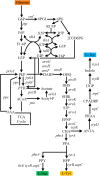Metabolic engineering for the production of l-phenylalanine in Escherichia coli
- PMID: 30800596
- PMCID: PMC6385074
- DOI: 10.1007/s13205-019-1619-6
Metabolic engineering for the production of l-phenylalanine in Escherichia coli
Abstract
As one of the three proteinogenic aromatic amino acids, l-phenylalanine is widely applied in the food, chemical and pharmaceutical industries, especially in production of the low-calorie sweetener aspartame. Microbial production of l-phenylalanine has become attractive as it possesses the advantages of environmental friendliness, low cost, and feedstock renewability. With the progress of metabolic engineering, systems biology and synthetic biology, production of l-phenylalanine from glucose in Escherichia coli with relatively high titer has been achieved by improving the intracellular levels of precursors, alleviating transcriptional repression and feedback inhibition of key enzymes, increasing the export of l-phenylalanine, engineering of global regulators, and overexpression of rate-limiting enzymes. In this review, successful metabolic engineering strategies for increasing l-phenylalanine accumulation from glucose in E. coli are described. In addition, perspectives for further improvement of production of l-phenylalanine are discussed.
Keywords: Escherichia coli; Glucose; Metabolic engineering; l-Phenylalanine.
Conflict of interest statement
Compliance with ethical standardsThe authors declare that they have no conflict of interest.
Figures
Similar articles
-
Metabolic engineering for improving L-tryptophan production in Escherichia coli.J Ind Microbiol Biotechnol. 2019 Jan;46(1):55-65. doi: 10.1007/s10295-018-2106-5. Epub 2018 Nov 13. J Ind Microbiol Biotechnol. 2019. PMID: 30426284 Review.
-
Construction of recombinant Escherichia coli for production of L-phenylalanine-derived compounds.World J Microbiol Biotechnol. 2021 Apr 15;37(5):84. doi: 10.1007/s11274-021-03050-1. World J Microbiol Biotechnol. 2021. PMID: 33855641 Review.
-
From scratch to value: engineering Escherichia coli wild type cells to the production of L-phenylalanine and other fine chemicals derived from chorismate.Appl Microbiol Biotechnol. 2007 Jun;75(4):739-49. doi: 10.1007/s00253-007-0931-y. Epub 2007 Apr 14. Appl Microbiol Biotechnol. 2007. PMID: 17435995 Review.
-
Novel technologies combined with traditional metabolic engineering strategies facilitate the construction of shikimate-producing Escherichia coli.Microb Cell Fact. 2017 Sep 29;16(1):167. doi: 10.1186/s12934-017-0773-y. Microb Cell Fact. 2017. PMID: 28962609 Free PMC article. Review.
-
Genetic engineering of Escherichia coli to improve L-phenylalanine production.BMC Biotechnol. 2018 Jan 30;18(1):5. doi: 10.1186/s12896-018-0418-1. BMC Biotechnol. 2018. PMID: 29382315 Free PMC article.
Cited by
-
Application of Amino Acids in the Structural Modification of Natural Products: A Review.Front Chem. 2021 Apr 29;9:650569. doi: 10.3389/fchem.2021.650569. eCollection 2021. Front Chem. 2021. PMID: 33996749 Free PMC article. Review.
-
Effects of Hydroxy-Alpha-Sanshool on Intestinal Metabolism in Insulin-Resistant Mice.Foods. 2022 Jul 10;11(14):2040. doi: 10.3390/foods11142040. Foods. 2022. PMID: 35885283 Free PMC article.
-
Engineering of phenylalanine dehydrogenase from Thermoactinomyces intermedius for the production of a novel homoglutamate.PLoS One. 2022 Mar 30;17(3):e0263784. doi: 10.1371/journal.pone.0263784. eCollection 2022. PLoS One. 2022. PMID: 35353822 Free PMC article.
-
Natural and engineered cyclodipeptides: Biosynthesis, chemical diversity, and engineering strategies for diversification and high-yield bioproduction.Eng Microbiol. 2022 Dec 24;3(1):100067. doi: 10.1016/j.engmic.2022.100067. eCollection 2023 Mar. Eng Microbiol. 2022. PMID: 39628525 Free PMC article. Review.
-
New Target Gene Screening Using Shortened and Random sgRNA Libraries in Microbial CRISPR Interference.ACS Synth Biol. 2023 Mar 17;12(3):800-808. doi: 10.1021/acssynbio.2c00595. Epub 2023 Feb 14. ACS Synth Biol. 2023. PMID: 36787424 Free PMC article.
References
-
- Boer LD, Dijkhuizen L. Microbial and enzymatic processes for l-phenylalanine production. Adv Biochem Eng Biotechnol. 1990;41:1–27.
Publication types
LinkOut - more resources
Full Text Sources
Research Materials


